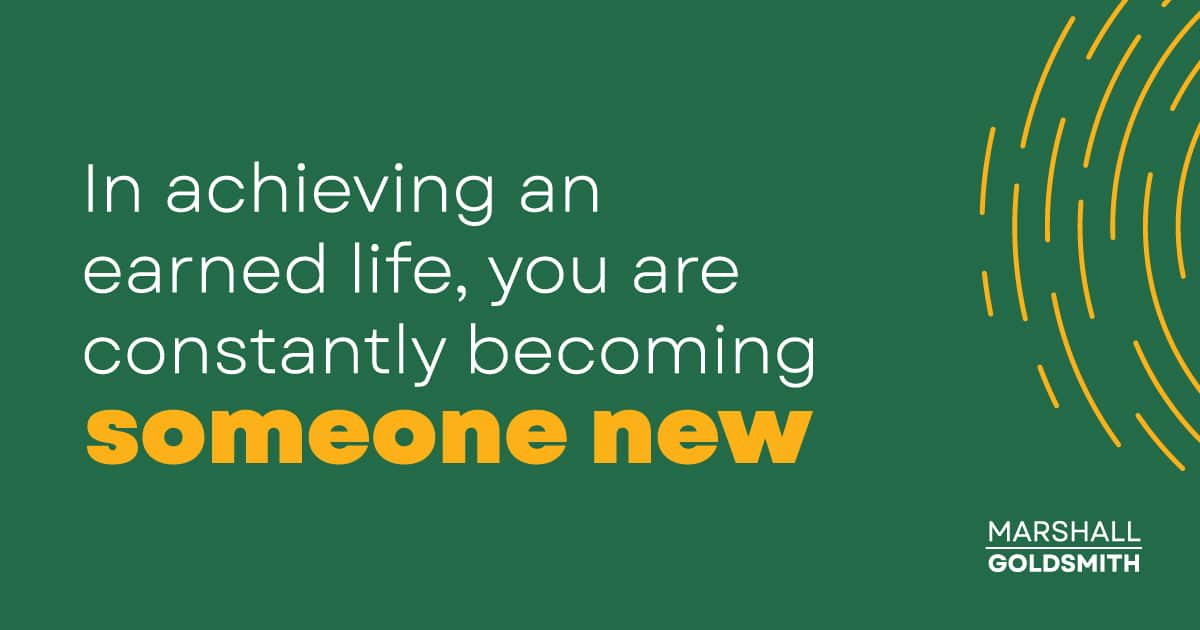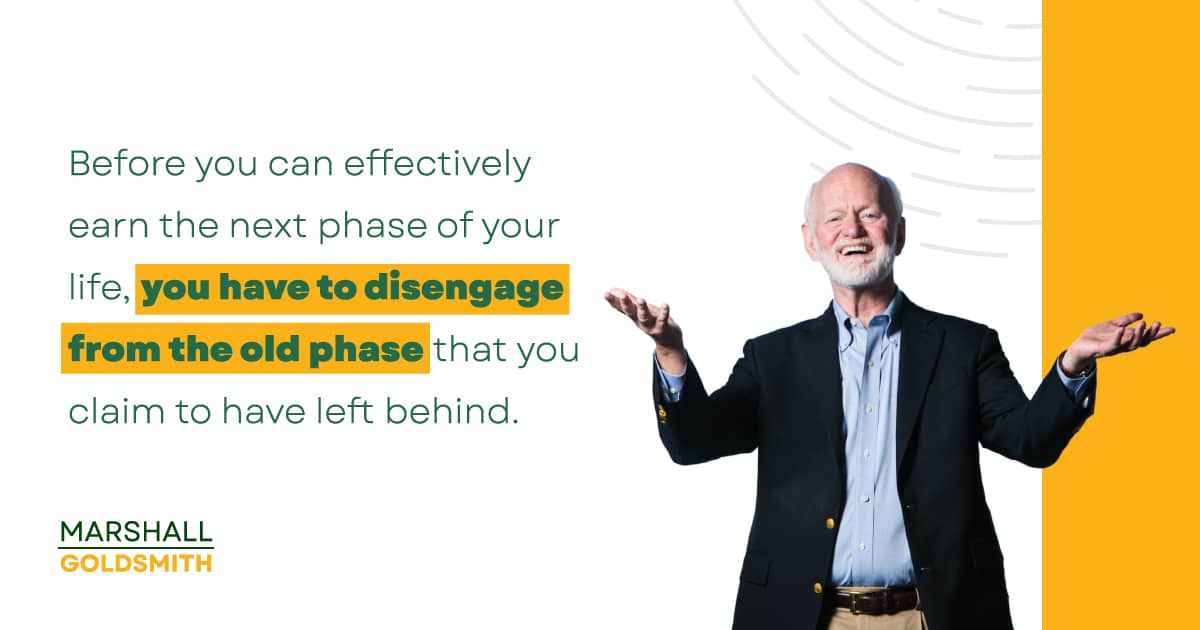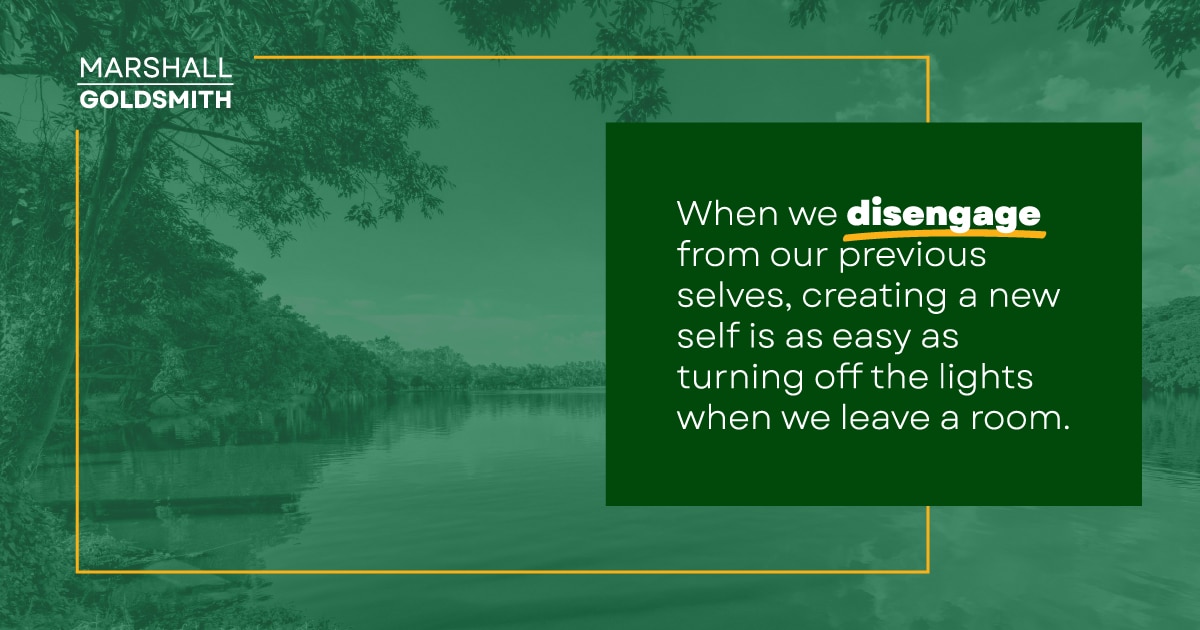Playing Favorites By Marshall Goldsmith There’s a reason I devote...
Our lives are marked by transitions where we move from one phase to another, as we continually change who we are and become someone new.
In achieving an earned life, you are constantly becoming someone new.
Before you can effectively earn the next phase of your life, you have to disengage from the old phase that you claim to have left behind.
You not only have to let go of past achievements (you are not the person who earned those achievements, that is, you have become someone new), you also have to relinquish your old identity and way of doing things. It’s okay to learn from our past, but I don’t recommend going back to visit every day.
When I first met the great football player Curtis Martin in 2018, it had been 12 years since he’d retired from the NFL. I was curious about how he handled the transition from pro athlete to civilian.
What did he miss? What had been difficult to let go? I expected him to mention the competition, his teammates, the cheering, the usual stuff we hear in postgame interviews. Silly me. I wasn’t close.

Curtis said he missed the “patterns” of being a professional athlete.
Players who make it to the NFL tend to be the best athlete in a generation from their high school. Since their early teens, they are noticed, coached, and cared for by well-intentioned adults. They never have to ask for any direction from their elders.
It is always coming their way, even when they are wealthy superstars in their 30s with minds of their own. From summer camp in July to the playoffs in January, every minute of an NFL player’s day is programmed and regimented: what to eat, when to work out, when to study film and memorize the playbook, when to practice, when to take therapy for injuries, when to show up for the team bus or jet.
It is not surprising that the most productive players come to correlate some portion of their success with the patterns of training and working they’ve adopted for so many years.
This is where the Every Breath Paradigm— “Every breath I take is a new me”—asserted itself for Curtis.

The Every Breath Paradigm comes from Buddha. When Gautama Buddha said, “Every breath I take is a new me,” he wasn’t speaking metaphorically. He meant it literally. Buddha was teaching that life is a progression of discrete moments of constant reincarnation from a previous you to a present you.
At one moment, through your choices and actions, you may experience pleasure, happiness, sadness, or fear. But that specific emotion doesn’t linger. With each breath, it alters, eventually vanishing. It was experienced by a previous you.
Whatever you hope will happen in your next breath, or the next day, or the next year will be experienced by a different you, the future-you. The only iteration of you that matters is the present-you who has just taken a breath.
When I explain the Every Breath Paradigm to clients, accustomed as they are to goal setting and high achievement, it takes a while for them to accept the primacy of now over the validating pleasures of remembering past successes or the future-facing buzz of pursuing an ambitious goal.
Curtis seemed to understand the Every Breath Paradigm instinctively.
Maybe it was Curtis’s awareness of the fragility of an athlete’s career, that you’re only as good as your last game and that you can’t rely on last season’s statistics to keep your job.
Maybe it was something coach Bill Parcells told him: “Curtis, you never want to take yourself out of the game—because the guy replacing you may never let you back on the field.”
But Curtis lives in the present, with his eye on the future. His past is always behind him, a relic he regards as a previous Curtis. Throughout his playing days, Curtis was operating on two tracks: Curtis the player and Curtis the former player.
On the “player track,” he adhered to the patterns he was given, knowing they provided the focus that led to success.
On the “former player track,” he was repurposing the lessons of football in real time into wisdom he could use for the rest of his life.
When he retired at 33, it wasn’t difficult for him to let go of his need for external direction —because he was ready to replace it with self-direction that came from within him (and that aligned with his larger aspiration, namely, to help others). He still needed “patterns” in his life, but now they were of his own making.
When we are able to disengage from our previous selves, letting go of all the patterns from our past to create a new self becomes as easy as turning off the lights when we leave a room.

Adding Too Much Value Won’t Get You There By Marshall...
C-Suite Master Class: No, But, However By Marshall Goldsmith Continuing...
The Doerr Institute: Expanding the Market for Coaches By Marshall...
Making Leadership Development Part of the College Degree at Rice...
Sanyin Siang – Winner of the Thinkers50 Marshall Goldsmith Coaching...
Thinkers50 Marshall Goldsmith Distinguished Achievement Award in Coaching – Nominees...
Leading with Influence: What Is Influence360°? By Marshall Goldsmith Founder...
Are You a Dominator, Manipulator, Persuader or Influencer? By Marshall...
Leading with Influence: Redefining Modern Influence Part 2 By Marshall...
My mission is simple. I want to help successful people achieve positive, lasting change and behavior; for themselves, their people, and their teams. I want to help you make your life a little better. With four decades of experience helping top CEOs and executives overcome limiting beliefs and behaviors to achieve greater success, I don’t do this for fame and accolades. I do this because I love helping people!
As an executive educator and coach, I help people understand how our beliefs and the environments we operate in can trigger negative behaviors. Through simple and practical advice, I help people achieve and sustain positive behavioral change.